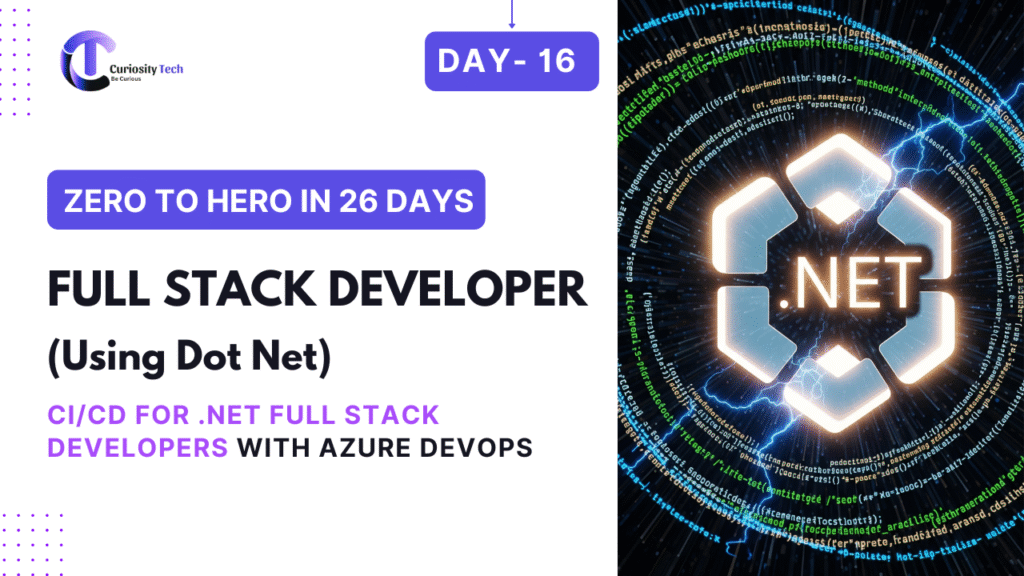Introduction
Continuous Integration (CI) and Continuous Deployment (CD) are essential for modern FullStack development. CI/CD automates building, testing, and deploying applications, reducing human error and speeding up delivery.
For .NET Full Stack developers, Azure DevOps provides a robust platform to implement CI/CD pipelines that integrate ASP.NET Core backend, EF Core database, and frontend frameworks like React or Angular. At CuriosityTech.in, learners get hands-on guidance to automate their entire application workflow.
1. Understanding CI/CD
| Concept | Purpose | Example |
| Continuous Integration (CI) | Automatically build and test code | Push code to GitHub → Azure DevOps triggers build pipeline |
| Continuous Deployment (CD) | Automatically deploy tested code | After successful CI, deploy to Azure Web App |
Flow Diagram:
[Developer Push Code] –> [CI Build Pipeline] –> [Automated Tests] –> [CD Deployment] –> [Production/QA]

2. Setting Up Azure DevOps Project
- Create an Azure DevOps account and new project.
- Connect your GitHub/Repo to Azure DevOps.
- Create a Pipeline → Select YAML or classic editor.
3. CI Pipeline for ASP.NET Core
Sample azure-pipelines.yml:
trigger:
branches:
include:
– main
pool:
vmImage: ‘windows-latest’
variables:
buildConfiguration: ‘Release’
steps:
– task: UseDotNet@2
inputs:
packageType: ‘sdk’
version: ‘7.0.x’
– task: NuGetToolInstaller@1
– task: NuGetCommand@2
inputs:
restoreSolution: ‘**/*.sln’
– task: VSBuild@1
inputs:
solution: ‘**/*.sln’
configuration: ‘$(buildConfiguration)’
– task: VSTest@2
inputs:
platform: ‘Any CPU’
configuration: ‘$(buildConfiguration)’
Explanation:
- Restores NuGet packages
- Builds the solution
- Runs unit tests
4. CD Pipeline for Deployment
Steps to Deploy to Azure Web App:
- Create an Azure App Service for your backend.
- Add Azure Subscription in DevOps.
- Add CD task in pipeline:
– task: AzureWebApp@1
inputs:
azureSubscription: ‘CuriosityTechAzure’
appType: ‘webApp’
appName: ‘CuriosityTechAPI’
package: ‘$(Build.ArtifactStagingDirectory)/**/*.zip’
Result: After successful CI, the app is deployed automatically to Azure.
5. Frontend Integration
- Build React or Angular apps in the CD pipeline:
– script: |
npm install
npm run build
displayName: ‘Build Frontend’
- Deploy frontend static files to Azure Storage or Web App.
Full Flow Diagram:

6. Real-World Project: CuriosityTech Course Portal
Scenario: Automate build and deployment of a FullStack course portal:
- Backend: ASP.NET Core Web API + EF Core
- Frontend: React application
- Deployment: Azure Web App + Azure SQL Database
- CI/CD ensures faster updates, error-free deployments, and rollback capability
Benefits:
- Automates repetitive tasks
- Integrates testing for quality assurance
- Deploys instantly after every successful merge
7. Best Practices
- Separate CI and CD pipelines for better control
- Use branch policies for code reviews before deployment
- Enable pipeline caching for faster builds
- Add unit, integration, and UI tests in CI
- Monitor pipelines for failures and automate rollback
8. CuriosityTech.in Mentorship Insights
- Learners build real-world CI/CD pipelines for FullStack .NET apps
- Stepwise guidance from code commit to live deployment
- Ensures industry-ready skills in automation and DevOps practices
Conclusion
CI/CD is a game-changer for FullStack .NET developers, enabling automated building, testing, and deployment of applications. With Azure DevOps pipelines, developers can deliver features faster and with fewer errors. At CuriosityTech.in, learners gain practical experience implementing CI/CD for secure, scalable FullStack projects.
The next step is Day 17 – Building Microservices with .NET and Docker, focusing on scalable architecture and containerization.



